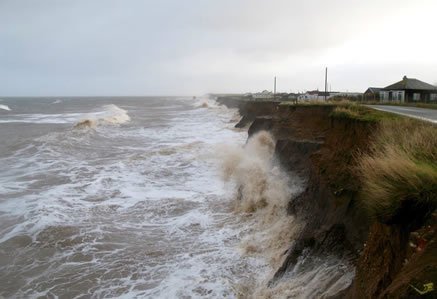Constructive wave
Find out more about constructive waves.
Constructive waves
Find out more about constructive waves.
Weak swash, strong backwash.
Find out more about destructive waves.
Destructive waves
Find out more about destructive waves.
Fetch, wind speed and wind duration.
Find out more about waves.
Corrosion/solution is when certain types of cliff erode as a result of weak acids in the sea.
Find out more about the processes of coastal erosion.
Abrasion occurs as breaking waves, concentrated between the high and low watermarks, which contain sand and larger fragments wear away the base of a cliff or headland. It is commonly known as the sandpaper effect. This process is particularly common in high-energy storm conditions.
Find out more about coastal erosion.
Corrasion is when destructive waves pick up beach material (e.g. pebbles) and hurl them at the base of a cliff. Over time this can loosen cliff material forming a wave-cut notch.
Find out more about coastal erosion.
Attrition is when waves cause rocks and pebbles to bump into each other and break up.
Find out more about coastal erosion.
Coastal erosion is the wearing away of the land by the sea.
Find out more about the processes of coastal erosion.
Chemical weathering is the breakdown of rock through changing its chemical composition.
Find out more about weathering.
Salt weathering is when salt spray from the sea gets into a crack in a rock. It may evaporate and crystallise, putting pressure on the surrounding rock and weakening the structure.
Find out more about weathering.
When rainwater hits rock it decomposes it or eats it away. This is known as carbonation. This occurs when slightly acidic (carbonic) rain or seawater comes into contact with sedimentary rock, such as limestone or chalk, it causes it to dissolve. A chemical reaction occurs between the acidic water and the calcium carbonate and forms calcium bicarbonate. This is soluble and is carried away in solution. Carbonation weathering occurs in warm, wet conditions.
Find out more about weathering.
Weathering is the breakdown of rock in situ by the action of rainwater, extremes of temperature, and biological activity.
Find out more about weathering.
Recently weathered rock can be seen at the foot of chalk and limestone cliffs and is easily identified because it is angular.
Find out more about weathering.
Solution, suspension, saltation and traction.
Find out more about coastal transportation.
The movement of sediment and beach material through wave action.
Find out more about coastal transportation.
Any three from:
- Waves enter an area of shallow water/waves enter a sheltered area, eg a cove or bay
- There is little wind
- A river or estuary flows into the sea reducing wave energy
- There is a good supply of material and the amount of material being transported is greater than the wave energy can transport.
Find out more about coastal deposition.
Littoral drift
Find out more about longshore drift.
Wave energy reduces leading to material being deposited.
Find out more about coastal deposition.

